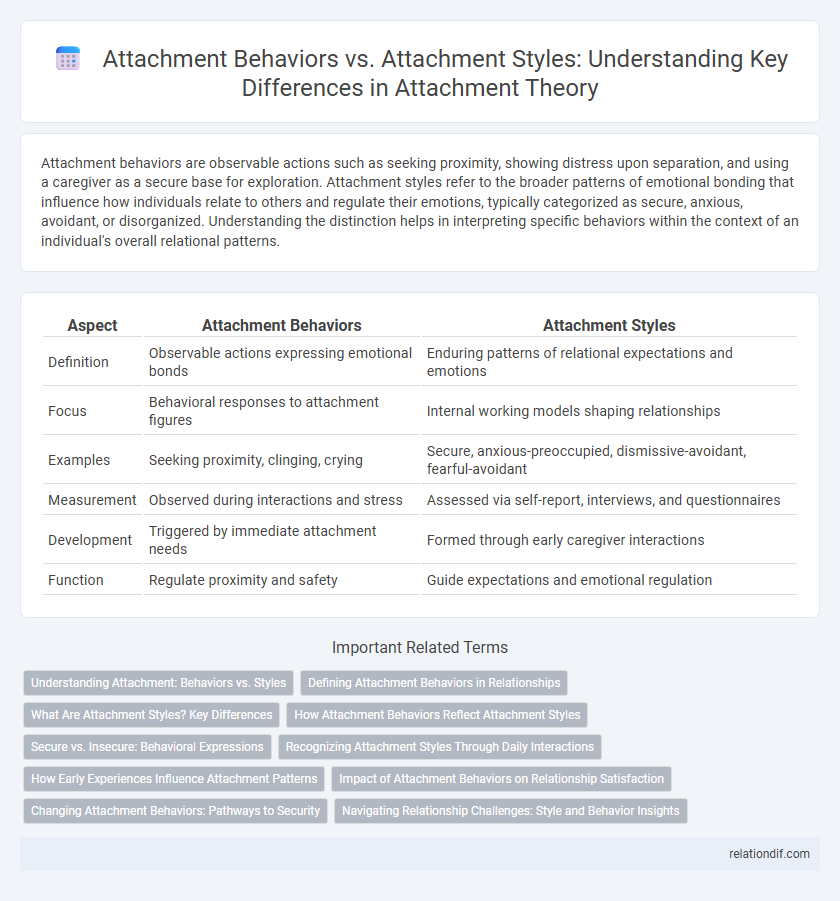Attachment behaviors are observable actions such as seeking proximity, showing distress upon separation, and using a caregiver as a secure base for exploration. Attachment styles refer to the broader patterns of emotional bonding that influence how individuals relate to others and regulate their emotions, typically categorized as secure, anxious, avoidant, or disorganized. Understanding the distinction helps in interpreting specific behaviors within the context of an individual's overall relational patterns.
Table of Comparison
| Aspect | Attachment Behaviors | Attachment Styles |
|---|---|---|
| Definition | Observable actions expressing emotional bonds | Enduring patterns of relational expectations and emotions |
| Focus | Behavioral responses to attachment figures | Internal working models shaping relationships |
| Examples | Seeking proximity, clinging, crying | Secure, anxious-preoccupied, dismissive-avoidant, fearful-avoidant |
| Measurement | Observed during interactions and stress | Assessed via self-report, interviews, and questionnaires |
| Development | Triggered by immediate attachment needs | Formed through early caregiver interactions |
| Function | Regulate proximity and safety | Guide expectations and emotional regulation |
Understanding Attachment: Behaviors vs. Styles
Attachment behaviors refer to the specific actions individuals exhibit to seek comfort or security from caregivers, such as crying, clinging, or proximity seeking. Attachment styles describe the overall patterns of emotional bonding shaped by repeated interactions, categorized as secure, anxious, avoidant, or disorganized. Understanding the distinction between attachment behaviors and styles is crucial for recognizing how early experiences influence emotional regulation and relationship patterns across the lifespan.
Defining Attachment Behaviors in Relationships
Attachment behaviors in relationships are the specific actions individuals display to maintain closeness and security with their partners, such as seeking comfort during stress or expressing affection through physical touch. These behaviors serve as immediate responses to perceived threats or separation, aiming to preserve emotional bonds and promote connection. Understanding attachment behaviors provides insight into how partners regulate intimacy and provide support within the dynamics of attachment styles like secure, anxious, or avoidant.
What Are Attachment Styles? Key Differences
Attachment styles refer to consistent patterns of emotional bonding and behavior developed in early relationships, categorized primarily as secure, anxious, avoidant, and disorganized. Attachment behaviors are specific actions displayed in relationships, such as seeking comfort or avoiding closeness, which vary depending on one's attachment style. The key difference lies in attachment behaviors being observable manifestations, while attachment styles represent the underlying psychological frameworks shaping these behaviors.
How Attachment Behaviors Reflect Attachment Styles
Attachment behaviors such as seeking proximity, distress upon separation, and using a caregiver as a secure base directly reflect underlying attachment styles like secure, anxious, or avoidant attachment. For example, secure attachment behaviors involve comfort in exploring the environment while maintaining closeness to the caregiver, whereas anxious attachment behaviors include heightened clinginess and difficulty calming down after separation. These observable actions serve as indicators of the internal working models defining each attachment style.
Secure vs. Insecure: Behavioral Expressions
Attachment behaviors reflect observable actions such as seeking proximity, comfort, and distress signals, while attachment styles represent underlying emotional patterns and expectations developed through early caregiver interactions. Secure attachment behaviors include confident exploration, effective communication of needs, and comfort with intimacy, whereas insecure attachment behaviors may manifest as avoidance, ambivalence, or anxious clinginess. These behavioral expressions correspond to secure attachment styles that foster resilience and trust, contrasted with insecure styles linked to emotional dysregulation and relational challenges.
Recognizing Attachment Styles Through Daily Interactions
Recognizing attachment styles through daily interactions involves observing consistent patterns in emotional responses and relationship behaviors, such as seeking comfort, handling conflict, or expressing trust. Attachment behaviors manifest as immediate reactions to stress or connection needs, while attachment styles represent deeper, enduring patterns formed through early caregiving experiences. Identifying secure, anxious, avoidant, or disorganized attachment styles offers crucial insight into interpersonal dynamics and guides healthier relational strategies.
How Early Experiences Influence Attachment Patterns
Early experiences with caregivers shape attachment behaviors by influencing how individuals respond to closeness, comfort, and trust. Repeated interactions during infancy lead to the development of distinct attachment styles, such as secure, anxious, avoidant, or disorganized, which guide emotional regulation and relationship dynamics throughout life. These patterns reflect internal working models formed through early caregiver responsiveness, consistency, and emotional availability.
Impact of Attachment Behaviors on Relationship Satisfaction
Attachment behaviors, including seeking proximity, showing affection, and expressing distress upon separation, directly influence relationship satisfaction by fostering emotional security and trust. Consistent positive attachment behaviors promote effective communication and conflict resolution, enhancing overall relational stability. Variations in these behaviors can lead to discrepancies in perceived support and intimacy, impacting partners' satisfaction levels.
Changing Attachment Behaviors: Pathways to Security
Changing attachment behaviors involves recognizing patterns of avoidance or anxiety and actively engaging in new relational experiences that promote trust and emotional safety. Therapeutic approaches like Emotionally Focused Therapy (EFT) and attachment-based counseling help individuals develop more secure attachment behaviors by fostering consistent responsiveness and open communication. These behavioral shifts often pave the way to establishing secure attachment styles, enhancing interpersonal relationships and overall emotional well-being.
Navigating Relationship Challenges: Style and Behavior Insights
Attachment behaviors represent the observable actions individuals use to seek closeness and security within relationships, while attachment styles reflect the underlying patterns of emotional bonding formed in early life. Navigating relationship challenges involves recognizing how secure, anxious, avoidant, or disorganized styles manifest through distinct behaviors like proximity-seeking, withdrawal, or ambivalence. Understanding these dynamics enhances communication and conflict resolution by aligning responses with both partner's attachment-driven needs and behaviors.
Attachment behaviors vs attachment styles Infographic

 relationdif.com
relationdif.com